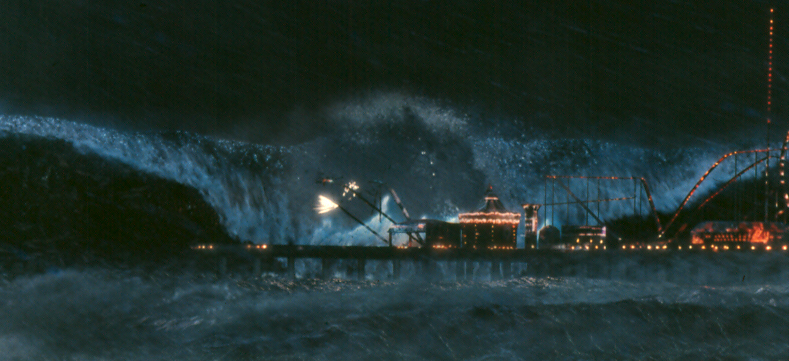
This week is the 20th anniversary of Brian De Palma’s Snake Eyes, a film perhaps not thought of for any major VFX moments. But, in fact, the movie nearly did feature a key CG water sequence in what was still the early days of fluid sims.
This was for the original ending, which involved a hurricane and a tidal wave hitting the Atlantic City boardwalk and killing the film’s villain, played Gary Sinise. ILM was behind the wave simulation and several miniature elements, but the scene was cut after test screening audiences reacted adversely.
Brian De Palma spoke briefly about this original Snake Eyes ending in the 2015 Noah Baumbach and Jake Paltrow documentary, De Palma, which also showed a large portion of the deleted scene.

“My concept was, when you’re dealing with such corruption, you need God to come down and blow it all away,” said De Palma in the documentary, referring to the murder conspiracy in Snake Eyes led by Gary Sinise’s character. “It’s the only way. It’s the only thing that works. That was the whole idea of the wave.”
“And nobody thought it worked,” De Palma added. “So we came up with something else, which I never particularly thought worked as well as the original idea.”
For the tidal wave, ILM – under visual effects supervisor Eric Brevig and associate visual effects supervisor Ed Hirsh – capitalised on earlier work the studio had pioneered in particles for Twister to conceptualise the breaking wave, it smashing into the pier and the immense amount of foam produced.

Among the Snake Eyes artists at ILM was Habib Zargarpour, who would later go on to be an associate visual effects supervisor for The Perfect Storm where, of course, incredibly elaborate CG fluid sims would be further realised.
Zargarpour told vfxblog that the Snake Eyes tidal wave was modelled and animated to break in a controlling way, and then shaded with a fractal shader. A mix of Softimage and Wavefront’s Dynamation was used to craft the computer graphics. “I’d also learned about fractals from Jimmy Mitchell on The Mask. He had this fractal shader, and he did a little bit of water, and all of a sudden my eyes just popped. I went, ‘Oh, my God, what you can do with this thing?!’ And that became the foundation of a lot of stuff I would do afterwards, in terms of particles work.”
“We messed with the fractals to get a particular look,” added Zargarpour, “just to get the semblance of particles that still look a bit like clouds for the foam. Then we’d try to refine the particles that are left behind, add a little spline to the mid-particles on the bleeding edge. And it would start to get a little more shape out of them.”

Zargarpour says one thing he particularly remembers discovering on the Snake Eyes tidal wave project was how to make particles not look like dirt and dust, but instead like water. “It was all in how you light it,” he noted. “The key was in pRender, the particle-rendering we had for Twister, where you could cheat the size of the particle from the light POV, from each light. So, the trick for making them look like water was to take the keylight, or backlight, and make the particles look really small from that light’s point of view. That made the light go through and scatter. Otherwise, it’s going to look like chunky ice cream.”
“But if you wanted a rim light from that light’s point of view,” continues Zargarpour, “you could make the particles like giant ice cream cones, and huge tennis balls, and then that would just hit this hard edge and give you a rim.”
Several splash elements were filmed in miniature for the tidal wave sequence, with some ultimately finding their way into parts of the ending that was preserved. However, the pier and theme park were 3D models. “We did this technique, which was basically to turn the model into a soft body,” explained Zargarpour. “When you make a soft body, you also make springs out of the polygon edges, and then how tight those edges are determines how much things stretch or not. So we usually made it pretty tight springs, but then the interconnectivity gets overwhelmed by gravity and turbulence.”

Although they were not seen, Snake Eyes’ tidal wave shots are part of a long line of ILM’s digital effects sequences involving tsunamis, storms and water sims. Interestingly, a different team worked on the CG water simulations for Deep Impact, released a few months earlier than Snake Eyes (see this vfxblog story with former ILMer Chris Horvath about a particular shot in Deep Impact).
And a final observation: fans of The Abyss might also be familiar with an original tidal wave sequence – produced by ILM with real wave and miniature footage that was both digitally and optically manipulated – that was cut from the 1989 film, but brought back for James Cameron’s special edition version.
